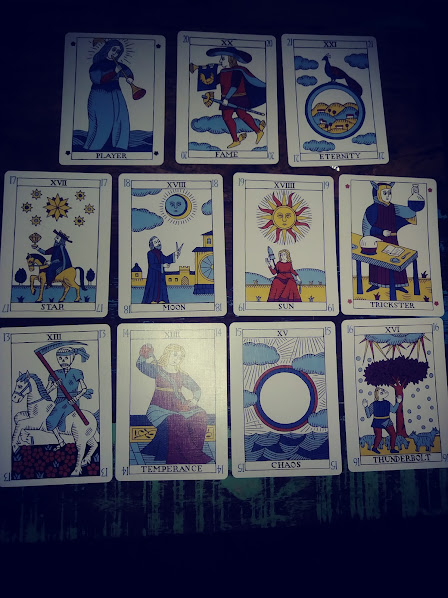If you've followed me awhile, you know I can't resist an off-the-beaten-path deck, on the condition that it's done well. Yes, decks like the RWS, Thoth, the Tarot Fortune Cards, various TdMs, Original Kipperkarten, and pre-1950 standard Lenormands are standbys that never really leave my reading table, but decks like the Vamp and the wonderful Yellow Submarine Lenormand have also found their way into regular rotation, as has every deck from BabaBarock that I've been able to get my hot little hands on. I do appreciate good art, but I never, ever purchase a deck for art alone. It has to read well and true - if I just want to gaze at great art, I prefer something big enough to hang on the wall, not keep stowed away in mothballs and looked at occasionally, if I even happen to remember it's there.
And that leads me to Ian Cumpstey's Rare Triumphs Tarot It's a reading deck, and also great art in the style of old TdM woodcuts And yes, it's a pip deck - but for those who haven't learned to read those yet, pips are quite simple, just learn the meanings of the numbers and suits and you've already got the card essences.And once you've boiled a card down to the essence, it can be unpacked to fit literally any context. As Andy Boroveshengra stated many times over, "The Tarot is a deck of playing cards." So playing card instructions will work. Here is a wonderful, comprehensive blog by my old internet friend Kapherus (Joel David) that will most assuredly provide you with everything you need to read pips. https://artofcartomancy.blogspot.com/p/basic-cartomancy-skills.html Additionally, you can pad this out with techniques like color pooling and more, as Andy described in Fortuna's Picturebook. That one seems to be offline now, but I hope it reappears or better yet, is published in book form. For those who are into intuitive reading, there are the works of Enrique Enriquez and Yoav Ben-Dov. For a more psychological take, there's Jodorowsky. And if you can read spanish, you're in luck - you can access the works of Tchalai Unger, who taught Jodorowsky.
With this deck, you aren't locked in. Reading these cards is as simple or as complex as you choose to make it. There is no having to remember Wirth's Hebrew letter correspondences vs. the Golden Dawn's, Hermetic Qabalah vs. Jewish Kabbalah, this or that person's astrological associations, you can use whatever elemental associations make sense to you, and it doesn't matter if you view the Hanged Man as a pittura infamante or a willing, transcendent sacrifice - because there is no Hanged Man. There are Majors, yes - but this deck slices cleanly through the gordian knot. The Majors are from various older decks like the Vieville and the Minchiate, and that's why the deck is titled Rare Triumphs. The images are historic, but without the baggage of the usual Majors that got all the attention. You can see some at the top of this post, as well as a few unnumbered extras. Here are the rest:
As you can see, they're different images but still familiar to those of us who have been knocking around Tarot for awhile. And Ian Cumpstey seems to know his subject inside out, and he's responsive to questions. I messaged him on Etsy asking why he chose to put the spinning woman on the Sun card, when I've only ever seen her on the Moon. Here is his reply, quoted with permission:
"Yes you are right she is on the Moon in Vieville and Brussels/Rouen cards ... but you will find the spinning lady under the Sun on some very old (and newer) Italian cards: hand-painted "Charles VI" /Estensi cards, also Rothschild-Beaux-Arts cards, as well as Bolognese Tarocchini. That's the tradition I've followed (same thing for
the astronomer(s) / moon card)."
It looks like I have some research to do! It will be interesting. But for those who don't like looking up various old decks and traditions, it isn't required to use this deck. There is a little sheet enclosed that sums up the essence of these cards succinctly. I won't reproduce the whole thing here, but showing a bit of it should be fine under Fair Use:
Here are some of the Minors, quite lovely with little details that can be used as mnemonic prompts, and playing card corner indices:
Pardon the glare from the flash on the Ace of Hearts. I decided to use this image anyway because you can see the finish on the cards - real, cambric fabric texture such as I haven't seen since childhood days at grandma's house. These are NOT the raised dots that pass for a "linen finish" nowadays!
Here are some more. The familiar Suicide King even has his heart on the floor. The Jack of Spades doesn't have his little dog, but there are dogs to be found elsewhere in the deck and besides, I need to research the decks mentioned by the artist.
You can get you own copy here, and there are several other wonderful decks available:
https://www.etsy.com/shop/IanCumpstey?ref=simple-shop-header-name&listing_id=941391086
Additionally, there are images to be seen here, much better than I could manage with my camera phone! https://www.instagram.com/skadipress/
It's one of those rare decks that can be read out of the box, but it can also take you down some rabbit holes of Tarot lore, should you choose to go. Now I'm off to order Ian's Commoners Playing Cards. German suits! Skatkarten! What's not to love?
I'll return at some point with a sample reading. This deck reads beautifully!









What a fantastic review and a beautiful set of cards. I love the colors and clean lines. It is tempting, but I will pass as I have added Nigel Jackson’s Rose Tarot to the reading table.
ReplyDeleteNigel Jackson does some beautiful work, I have a couple of his decks. Not the Rose, though. I hope you let us know how you like it.
Delete